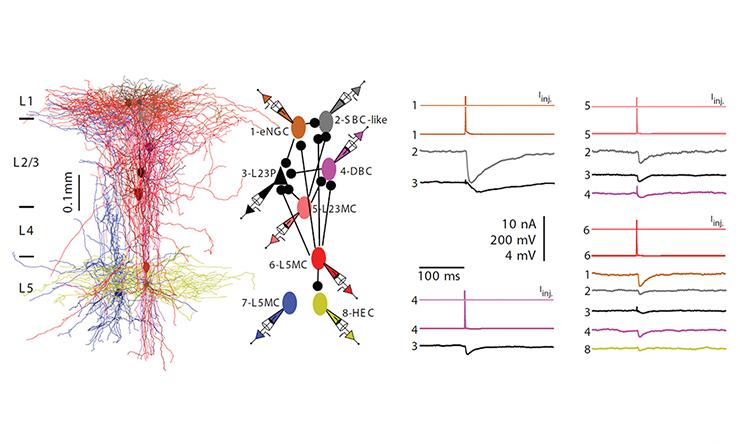
Single-cell RNA-sequencing
Single-cell RNA-sequencing protocols (drop-seq and Patch-seq) are combined to understand cellular diversity across brain regions and species.

Simultaneous 8-cell Patch-clamp Recording
Simultaneous 8-cell patch-clamp recording of mouse cortex to understand the electrophysiology, morphology and connectivity of mouse cortex neurons.
About the Lab
Dissecting cortical microcircuit in health and disease; connectopathies in epilepsy and autism spectrum disorders
Each brain region is composed of distinct neuronal cell types with characteristic morphological, electrophysiological, and molecular properties, and these cell types are wired in a specific manner to form a functional circuit. A mechanistic understanding of the workings of the normal and pathological brain requires identifying all of the constituent cell types, mapping their interconnections, and determining their functions.
Our laboratory focuses on three related questions regarding brain circuits:
- How many cell types are there in each brain region and how they connect each other to form a normal, functional circuit
- What are unique cell types and organization principles that may have been evolved to endow the primate brain with superb computational capabilities for the complex cognitive processes characteristic of primates
- How stereotypical wiring principles among cell types are impacted by distinct neuropsychiatric conditions?
To this end, we developed and employ a multi-disciplinary approach that includes multi-cell patch recording (up to 12 simultaneous recordings), morphological recovery, single-cell RNA sequencing, optogenetic techniques, and machine learning. Using this integrated approach, we perform large-scale, multidisciplinary profiling of individual neurons in a brain circuit, including their electrophysiological properties, morphology, transcriptome, and connections, to decipher the comprehensive circuit blueprint in different brain regions across species. We also use sophisticated mouse genetic models, in vivo whole-cell recordings, two-photon calcium imaging, and behavioral assays to dissect the functional roles of each cell type in the information processing.
In parallel, we use the same approach to decipher aberrant connections between specific cell types (connectopathies) underlying neuropsychiatric disorders, including epilepsy, autism spectrum disorders, and schizophrenia. Extensive research has been done to probe these disorders at genetic/molecular, macro-scale, and behavior levels. However, at the meso-scale level, how each neuropsychiatric condition impacts the circuit blueprint remains largely unknown. Furthermore, for each brain disorder, etiologies could be highly diverse despite shared symptomatology and EEG signature, raising the possibility that different etiologies induce the same circuit wiring deficits that result in the same phenotypes. Identifying the stereotypical circuit deficits for a specific type of neuropsychiatric disease paves the way for more universal, circuit-based cell-type specific interventions for these diseases.
Open Positions
The Jiang Lab is looking for talented and motivated postdocs and graduate students to participate in our research.
Postdoctoral Fellow Positions
We are currently actively recruiting for postdoctoral fellow positions with experimental or computational emphasis. View and apply to the job posting.
Graduate Students
We welcome graduate students to join the lab and participate in our research. Contact Xiaolong Jiang at xiaolonj@bcm.edu to discuss details. See our Graduate School website for more information: applying for our programs.








